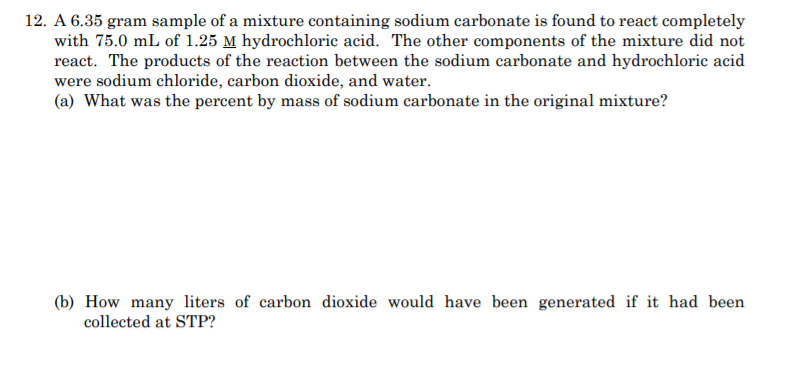12. A 6.35 gram sample of a mixture containing sodium carbonate is found to react completely with 75.0 mL of 1.25 M hydrochloric acid. The other components of the mixture did not react. The products of the reaction between the sodium carbonate and hydrochloric acid were sodium chloride, carbon dioxide, and water. (a) What was the percent by mass of sodium carbonate in the original mixture? (b) How many liters of carbon dioxide would have been generated if it had been collected at STP?
12. A 6.35 gram sample of a mixture containing sodium carbonate is found to react completely with 75.0 mL of 1.25 M hydrochloric acid. The other components of the mixture did not react. The products of the reaction between the sodium carbonate and hydrochloric acid were sodium chloride, carbon dioxide, and water. (a) What was the percent by mass of sodium carbonate in the original mixture? (b) How many liters of carbon dioxide would have been generated if it had been collected at STP?
Chemistry
10th Edition
ISBN:9781305957404
Author:Steven S. Zumdahl, Susan A. Zumdahl, Donald J. DeCoste
Publisher:Steven S. Zumdahl, Susan A. Zumdahl, Donald J. DeCoste
Chapter4: Types Of Chemical Reactions And Solution Stoichiometry
Section: Chapter Questions
Problem 106AE: Many over-the-counter antacid tablets are now formulated using calcium carbonate as die active...
Related questions
Question

Transcribed Image Text:12. A 6.35 gram sample of a mixture containing sodium carbonate is found to react completely
with 75.0 mL of 1.25 M hydrochloric acid. The other components of the mixture did not
react. The products of the reaction between the sodium carbonate and hydrochloric acid
were sodium chloride, carbon dioxide, and water.
(a) What was the percent by mass of sodium carbonate in the original mixture?
(b) How many liters of carbon dioxide would have been generated if it had been
collected at STP?
Expert Solution
This question has been solved!
Explore an expertly crafted, step-by-step solution for a thorough understanding of key concepts.
This is a popular solution!
Trending now
This is a popular solution!
Step by step
Solved in 2 steps with 2 images

Knowledge Booster
Learn more about
Need a deep-dive on the concept behind this application? Look no further. Learn more about this topic, chemistry and related others by exploring similar questions and additional content below.Recommended textbooks for you

Chemistry
Chemistry
ISBN:
9781305957404
Author:
Steven S. Zumdahl, Susan A. Zumdahl, Donald J. DeCoste
Publisher:
Cengage Learning

World of Chemistry, 3rd edition
Chemistry
ISBN:
9781133109655
Author:
Steven S. Zumdahl, Susan L. Zumdahl, Donald J. DeCoste
Publisher:
Brooks / Cole / Cengage Learning

Principles of Modern Chemistry
Chemistry
ISBN:
9781305079113
Author:
David W. Oxtoby, H. Pat Gillis, Laurie J. Butler
Publisher:
Cengage Learning

Chemistry
Chemistry
ISBN:
9781305957404
Author:
Steven S. Zumdahl, Susan A. Zumdahl, Donald J. DeCoste
Publisher:
Cengage Learning

World of Chemistry, 3rd edition
Chemistry
ISBN:
9781133109655
Author:
Steven S. Zumdahl, Susan L. Zumdahl, Donald J. DeCoste
Publisher:
Brooks / Cole / Cengage Learning

Principles of Modern Chemistry
Chemistry
ISBN:
9781305079113
Author:
David W. Oxtoby, H. Pat Gillis, Laurie J. Butler
Publisher:
Cengage Learning

Chemistry: An Atoms First Approach
Chemistry
ISBN:
9781305079243
Author:
Steven S. Zumdahl, Susan A. Zumdahl
Publisher:
Cengage Learning


Chemistry: Principles and Practice
Chemistry
ISBN:
9780534420123
Author:
Daniel L. Reger, Scott R. Goode, David W. Ball, Edward Mercer
Publisher:
Cengage Learning